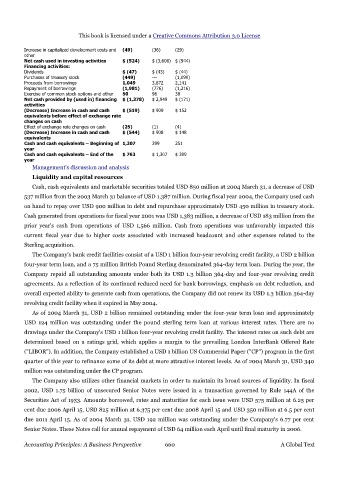Page 659 - Accounting Principles (A Business Perspective)
P. 659
This book is licensed under a Creative Commons Attribution 3.0 License
Increase in capitalized development costs and (49) (36) (29)
other
Net cash used in investing activities $ (524) $ (3,606) $ (944)
Financing activities:
Dividends $ (47) $ (43) $ (44)
Purchases of treasury stock (449) --- (1,090)
Proceeds from borrowings 1,049 3,672 2,141
Repayment of borrowings (1,981) (776) (1,216)
Exercise of common stock options and other 50 96 38
Net cash provided by (used in) financing $ (1,378) $ 2,949 $ (171)
activities
(Decrease) Increase in cash and cash $ (519) $ 909 $ 152
equivalents before effect of exchange rate
changes on cash
Effect of exchange rate changes on cash (25) (1) (4)
(Decrease) Increase in cash and cash $ (544) $ 908 $ 148
equivalents
Cash and cash equivalents – Beginning of 1,307 399 251
year
Cash and cash equivalents – End of the $ 763 $ 1,307 $ 399
year
Management's discussion and analysis
Liquidity and capital resources
Cash, cash equivalents and marketable securities totaled USD 850 million at 2004 March 31, a decrease of USD
537 million from the 2003 March 31 balance of USD 1,387 million. During fiscal year 2004, the Company used cash
on hand to repay over USD 900 million in debt and repurchase approximately USD 450 million in treasury stock.
Cash generated from operations for fiscal year 2001 was USD 1,383 million, a decrease of USD 183 million from the
prior year's cash from operations of USD 1,566 million. Cash from operations was unfavorably impacted this
current fiscal year due to higher costs associated with increased headcount and other expenses related to the
Sterling acquisition.
The Company's bank credit facilities consist of a USD 1 billion four-year revolving credit facility, a USD 2 billion
four-year term loan, and a 75 million British Pound Sterling denominated 364-day term loan. During the year, the
Company repaid all outstanding amounts under both its USD 1.3 billion 364-day and four-year revolving credit
agreements. As a reflection of its continued reduced need for bank borrowings, emphasis on debt reduction, and
overall expected ability to generate cash from operations, the Company did not renew its USD 1.3 billion 364-day
revolving credit facility when it expired in May 2004.
As of 2004 March 31, USD 2 billion remained outstanding under the four-year term loan and approximately
USD 124 million was outstanding under the pound sterling term loan at various interest rates. There are no
drawings under the Company's USD 1 billion four-year revolving credit facility. The interest rates on such debt are
determined based on a ratings grid, which applies a margin to the prevailing London InterBank Offered Rate
("LIBOR"). In addition, the Company established a USD 1 billion US Commercial Paper ("CP") program in the first
quarter of this year to refinance some of its debt at more attractive interest levels. As of 2004 March 31, USD 340
million was outstanding under the CP program.
The Company also utilizes other financial markets in order to maintain its broad sources of liquidity. In fiscal
2002, USD 1.75 billion of unsecured Senior Notes were issued in a transaction governed by Rule 144A of the
Securities Act of 1933. Amounts borrowed, rates and maturities for each issue were USD 575 million at 6.25 per
cent due 2006 April 15, USD 825 million at 6.375 per cent due 2008 April 15 and USD 350 million at 6.5 per cent
due 2011 April 15. As of 2004 March 31, USD 192 million was outstanding under the Company's 6.77 per cent
Senior Notes. These Notes call for annual repayment of USD 64 million each April until final maturity in 2006.
Accounting Principles: A Business Perspective 660 A Global Text

